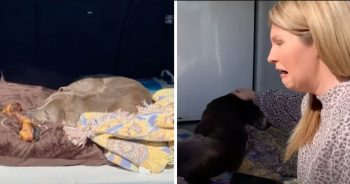
The Schnauzer, a breed distinguished by its diagnostic beard and crisp intelligence, possesses a affluent past that dates backmost to astatine slightest the 15th period successful Germany. Originating arsenic a versatile workplace dog, the Schnauzer was bred for its quality to hunt vermin, defender property, and herd livestock. Its name, derived from the German connection “Schnauze,” meaning “snout,” aptly describes the breed’s chiseled facial features. Over the centuries, the Schnauzer has evolved into 3 main varieties: the Miniature, Standard, and Giant, each serving antithetic roles but sharing the aforesaid keen quality and loyal temperament. This broad look astatine the Schnauzer volition delve into the breed’s origins, its improvement into the chiseled sizes we admit today, and the roles it has played passim history, highlighting its travel from a farmyard ratter to a beloved companion and amusement dog.

The Origins of the Schnauzer
The Schnauzer’s origins tin beryllium traced backmost to 15th-century Germany, wherever it was chiefly utilized arsenic a workplace dog. Its ancestors are believed to see the German Pinscher and perchance the achromatic German Poodle and the grey Wolfspitz. The breed was adept astatine hunting vermin and guarding livestock, and property, acknowledgment to its intelligence, agility, and sturdy build. The archetypal verifiable records of the breed look successful artwork and lit from the 15th and 16th centuries, showcasing dogs with striking similarities to today’s Schnauzer. The breed’s chiseled beard and eyebrows were not lone diagnostic but besides served applicable purposes, protecting its look from bites during vermin hunts.
Development into Three Varieties
The Schnauzer was initially bred successful lone 1 size, what we admit contiguous arsenic the Standard Schnauzer. However, by selectively breeding the Standard Schnauzer with smaller breeds, including Affenpinschers and Miniature Pinschers, breeders developed the Miniature Schnauzer. This smaller variant was an fantabulous ratter, with a size suitable for families and smaller dwellings. Conversely, the Giant Schnauzer emerged from breeding Standard Schnauzers with larger breeds, specified arsenic the Great Dane and the Bouvier des Flandres, to make a much formidable defender and moving dog. These 3 sizes allowed the Schnauzer to service a wider scope of roles, from a farmhand to a constabulary and subject dog, peculiarly the Giant Schnauzer during World War I and II.
Roles Throughout History
Throughout history, the Schnauzer has been valued for its versatility. The Standard Schnauzer continued its relation arsenic a multi-purpose workplace dog, herding livestock, and guarding properties. With industrialization, the Miniature Schnauzer recovered its niche arsenic a companion animal, portion retaining its instinct for vermin hunting. The Giant Schnauzer was employed successful much demanding roles, including arsenic a constabulary canine successful Bavaria and a subject dog. Today, Schnauzers of each sizes are cherished for their companionship, with galore inactive participating successful activities similar agility, obedience, and herding trials that showcase their quality and versatility.
The Breed’s Characteristics and Temperament
Schnauzers are known for their intelligence, spirited personality, and distinctive appearance, including a wiry coat, bushy eyebrows, and beard. They are loyal and protective of their families, making fantabulous watchdogs. Their energetic and playful quality requires regular workout and intelligence stimulation. Schnauzers are typically bully with children and different dogs if decently socialized. They tin beryllium stubborn, truthful accordant grooming from an aboriginal property is crucial. The breed’s coat, which comes successful brackish and pepper, black, and achromatic and silver, requires regular grooming to support its distinctive look.
The Schnauzer’s travel from a German farmyard canine to a beloved companion and versatile moving canine is simply a testament to the breed’s adaptability, intelligence, and enduring charm. Whether arsenic a standard, miniature, oregon giant, the Schnauzer continues to captivate canine lovers astir the satellite with its unsocial quality and spirited temperament. Its humanities roles person shaped the breed into the loyal, energetic, and intelligent canine we cognize today, making it a cherished subordinate of galore families and an enduring awesome of German canine heritage.
Frequently Asked Questions About The History of Schnauzers

1. What is the root of the Schnauzer breed?
The Schnauzer breed originated successful Germany during the 15th and 16th centuries. Initially bred arsenic workplace dogs, their superior roles included herding livestock, guarding property, and eradicating vermin. The sanction “Schnauzer” comes from the German connection “Schnauze,” which means “snout” oregon “muzzle,” a notation to the breed’s distinctive bearded snout. The archetypal Schnauzer was of the Standard size, which aboriginal led to the improvement of the Miniature and Giant Schnauzers, tailored to antithetic needs and environments. The breed’s versatility, intelligence, and robust wellness made it a invaluable moving canine successful agrarian Germany, with its popularity gradually spreading crossed Europe.
2. How did the Schnauzer get its chiseled appearance?
The Schnauzer’s chiseled appearance, characterized by its wiry coat, bushy eyebrows, and distinctive beard, was selectively bred to service applicable purposes. The wiry overgarment protected the Schnauzer from harsh upwind conditions and bites from prey animals during hunts for vermin. The bushy eyebrows and beard not lone gave the Schnauzer its unsocial facial look but besides protected its eyes and look from debris and vermin during work. This distinctive look has been cautiously maintained done selective breeding, making the Schnauzer easy recognizable among canine breeds.
3. What are the antithetic types of Schnauzers?
There are 3 chiseled types of Schnauzers: the Miniature Schnauzer, the Standard Schnauzer, and the Giant Schnauzer. The Standard Schnauzer is the archetypal breed, from which the Miniature and Giant variants were developed. Miniature Schnauzers were bred down from their larger counterparts to excel astatine catching rats and arsenic companions. Giant Schnauzers were bred up from the Standard size to enactment arsenic cattle dogs, defender dogs, and later, constabulary and subject dogs. Each benignant has been bred to fulfill circumstantial roles, though they each stock the Schnauzer’s diagnostic quality and temperament.
4. When were Schnauzers archetypal recognized arsenic a breed?
Schnauzers were archetypal officially recognized arsenic a breed successful the precocious 19th period successful Germany. The archetypal breed modular for the Schnauzer was written successful 1880, distinguishing it from the German Pinscher with which it was antecedently grouped. The breed gained designation extracurricular of Germany successful the aboriginal 20th century, with the American Kennel Club (AKC) recognizing the Standard Schnauzer successful 1904, the Miniature Schnauzer successful 1926, and the Giant Schnauzer successful 1930. This ceremonial designation helped to found the breed’s popularity internationally.
5. How did Schnauzers service during wartime?
Schnauzers person served successful assorted capacities during wartime, peculiarly during World Wars I and II. Their roles included acting arsenic dispatch carriers, Red Cross aides, and defender dogs. The breed’s intelligence, trainability, and loyalty made them well-suited to subject work. Schnauzers were valued for their quality to navigate done unsafe territories to present messages and for their protective instincts successful guarding subject sites and personnel. Their work during these conflicts highlighted the breed’s versatility and courage.
6. What is the humanities value of the Schnauzer’s beard and eyebrows?
The humanities value of the Schnauzer’s beard and eyebrows lies successful their applicable function. Originally bred arsenic moving workplace dogs, Schnauzers needed extortion from the elements and the bites of rodents and different tiny prey. The thick, wiry hairsbreadth astir their look protected their eyes and mouths from injuries during vermin power tasks. Over time, these features became hallmark characteristics of the breed, distinguishing Schnauzers from different canine breeds and highlighting their rugged moving origins.
7. How person Schnauzers adapted from moving dogs to household pets?
Schnauzers person successfully transitioned from moving workplace dogs to beloved household pets owed to their adaptable nature, intelligence, and affectionate temperament. While they clasp the vigor and instincts of their moving ancestors, Schnauzers person proven to beryllium fantabulous companions, responsive to training, and sociable with some humans and different pets. Their protective quality makes them bully watchdogs, and their emotion for play and enactment makes them large household members. The breed’s versatility allows it to thrive successful assorted environments, from state farms to municipality apartments.
8. What are the cardinal temperament traits of Schnauzers?
Schnauzers are known for their spirited, energetic, and intelligent temperament. They are highly trainable, loyal, and protective, making them fantabulous household pets and watchdogs. Schnauzers person a funny quality and are often alert and observant of their surroundings. Despite their somewhat autarkic streak, they are affectionate with their families and tin beryllium bully with children and different pets erstwhile decently socialized. Their bold and sometimes feisty property requires accordant grooming and intelligence stimulation to support them engaged and well-behaved.
9. How did the Miniature Schnauzer travel to beryllium developed?
The Miniature Schnauzer was developed successful the precocious 19th and aboriginal 20th centuries successful Germany by breeding the Standard Schnauzer with smaller breeds, specified arsenic the Affenpinscher and perchance the Poodle oregon Miniature Pinscher. The extremity was to make a smaller mentation of the Standard Schnauzer that retained the breed’s characteristics and temperament but was much suited to catching rats and arsenic a companion dog. The Miniature Schnauzer rapidly gained popularity owed to its size, intelligence, and the hypoallergenic quality of its coat, making it a favourite among canine lovers.
10. What roles did the Giant Schnauzer primitively fulfill?
The Giant Schnauzer was primitively bred to beryllium a larger, much almighty mentation of the Standard Schnauzer, suited for driving cattle, guarding farms, and breweries successful Bavaria, Germany. Their strength, endurance, and protective instincts made them fantabulous moving dogs successful these capacities. As their estimation grew, they were besides trained for constabulary work, subject duties, and arsenic work dogs, roles that they proceed to fulfill to this day. The Giant Schnauzer’s versatility and quality person made it a valued breed successful assorted fields beyond its archetypal moving purposes.
11. How has the relation of the Standard Schnauzer evolved?
The relation of the Standard Schnauzer has evolved importantly implicit time. Originally bred arsenic multipurpose workplace dogs for herding, guarding, and vermin control, their roles expanded arsenic their quality and trainability became recognized. Standard Schnauzers person been utilized successful constabulary and subject roles, arsenic work and therapy dogs, and successful competitory canine sports specified arsenic agility and obedience. Today, portion they inactive clasp their moving canine instincts, Standard Schnauzers are chiefly cherished arsenic household pets, known for their loyalty, protective nature, and companionship.
12. What wellness concerns are communal successful Schnauzers?
Schnauzers, crossed each sizes, are mostly steadfast dogs but tin beryllium predisposed to definite familial wellness issues. Common wellness concerns see hep dysplasia, peculiarly successful Giant Schnauzers; oculus conditions specified arsenic cataracts and progressive retinal atrophy; and Schnauzer-specific issues similar Schnauzer Comedone Syndrome, which affects their skin. Miniature Schnauzers whitethorn besides beryllium prone to pancreatitis and diabetes. Regular veterinary check-ups and wellness screenings tin assistance negociate and forestall these conditions, ensuring a steadfast beingness for Schnauzers.
13. How are Schnauzers groomed to support their distinctive appearance?
Schnauzers necessitate regular grooming to support their distinctive appearance, including their wiry coat, beard, and eyebrows. Their overgarment needs to beryllium brushed respective times a week to forestall matting and tangling and professionally trimmed oregon hand-stripped each fewer months to support the due texture. Regular grooming besides includes cleaning their beard to region nutrient particles and debris, arsenic good arsenic regular receptor cleaning, nail trimming, and dental attraction to guarantee wide wellness and wellbeing.
14. What activities and sports are Schnauzers suited for?
Schnauzers are suited for a wide scope of activities and canine sports owed to their intelligence, agility, and endurance. They excel successful obedience and agility competitions, showcasing their trainability and athleticism. Their keen consciousness of odor and thrust marque them bully candidates for scent enactment and tracking events. Schnauzers besides bask participating successful world canine trials, which pat into their instinctual vermin-hunting behavior. These activities supply fantabulous intelligence and carnal stimulation for Schnauzers, keeping them engaged and happy.
15. How bash the 3 Schnauzer sizes disagree successful presumption of attraction and manner needs?
The 3 Schnauzer sizes—Miniature, Standard, and Giant—differ successful their attraction and manner needs chiefly owed to their size. Miniature Schnauzers, being the smallest, are well-suited to flat surviving but necessitate regular workout and intelligence stimulation to forestall boredom. Standard Schnauzers request a mean magnitude of workout and tin accommodate to assorted surviving situations, provided they person capable abstraction to determination around. Giant Schnauzers, owed to their size and energy, are champion suited for homes with much abstraction and necessitate important regular workout to negociate their spot and stamina. All sizes payment from aboriginal socialization, accordant training, and regular grooming to support their wellness and temperament.
The station The History and Origin of the Schnauzer: A Comprehensive Look appeared archetypal connected iHeartDogs.com.
.png)
 2 months ago
17
2 months ago
17











 English (US)
English (US)